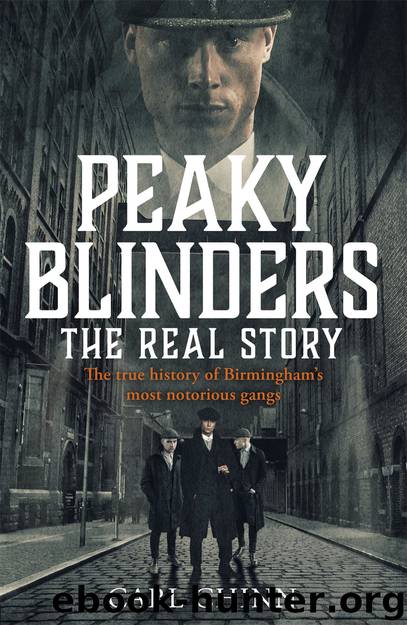Peaky Blinders by Carl Chinn

Author:Carl Chinn
Language: eng
Format: epub
Publisher: John Blake
Published: 2019-09-19T16:00:00+00:00
Outbreaks of ruffianism did occur in Aston after Superintendent Walker’s retirement, but the reign of the slogging gangs was almost over in the district. Within a few years, the peaky blinders in Birmingham had also been put down. So what happened to them? In 1915, the Birmingham Mail reported that, like the rigorous young vagabonds who preferred a roving life to one in which work formed a part’, many peaky blinders had joined the Army and made good soldiers, too. Others had found respectable jobs with employers prepared to engage unskilled workers. It was emphasised that, ‘No one is more delighted than the local police, to whom these young “peaky blinders”, as they used to be called, were a never-ending source of trouble.’298
Reminiscing forty years later, Hawkins, the letter writer to the Birmingham Weekly Post, agreed that the First World War saw the end of the gangs: ‘Many were in the old militia and were called up and many joined the Regular Army. Few returned and they were older and more disciplined and settled down.’299
Henry Lightfoot, the first man to be specifically called a peaky blinder, exemplifies the perceptive observations of Hawkins. So too does George Hickling. Hickling was one of the notorious Ten Arches Gang of Aston, named after the railway viaduct crossing the Birmingham to Fazeley Canal at Holborn Hill, and first mentioned in 1883.300 In May 1900, George Hickling and his brother, Thomas, ‘two young men of the peaky type’ were charged with having thrown stones and brickbats that broke a window at the Church Inn on the Lichfield Road, where a man they disliked was drinking. The brothers were found guilty and jailed for one month as they could not pay the damages, fine and costs required of them.301
Fifteen years later, George Hickling joined the Army, but as he was temporarily unfit he was transferred to the Reserve before he re-joined the colours with the Royal Berkshire Regiment in May 1916. Just five feet, 4 inches tall, he was aged thirty-nine and a bill poster. Soon after, Hickling married Clara Timmins at St Mary’s, Aston Brook. They had been cohabiting for seventeen years and had two illegitimate children. Living in a back house in Powell Street, they wed so that, presumably, Clara and their children could receive a separation allowance. Later, Hickling was assigned to the 17th Company, the 3rd Labour Battalion. It included men who were medically rated as below the ‘A1’ condition required for front line service. Hickling was BII. He was discharged in March 1919 with a 20 per cent disability of deafness and a pension for 26 weeks of 5 shillings and sixpence a week. His character was given as good.302
The peaky blinders continued to be written about, but now in the past tense. In 1925, in an article on the improvements in Birmingham, it was stressed that one important positive change was in the keeping of the peace, for the ‘bell bottom trousered and outrageously capped roughs who were a real
Download
This site does not store any files on its server. We only index and link to content provided by other sites. Please contact the content providers to delete copyright contents if any and email us, we'll remove relevant links or contents immediately.
Cecilia; Or, Memoirs of an Heiress — Volume 1 by Fanny Burney(32408)
Cecilia; Or, Memoirs of an Heiress — Volume 3 by Fanny Burney(31812)
Cecilia; Or, Memoirs of an Heiress — Volume 2 by Fanny Burney(31785)
The Great Music City by Andrea Baker(31245)
We're Going to Need More Wine by Gabrielle Union(18946)
All the Missing Girls by Megan Miranda(15478)
Pimp by Iceberg Slim(14305)
Bombshells: Glamour Girls of a Lifetime by Sullivan Steve(13949)
Talking to Strangers by Malcolm Gladwell(13180)
Norse Mythology by Gaiman Neil(13166)
Fifty Shades Freed by E L James(13143)
For the Love of Europe by Rick Steves(12569)
Mindhunter: Inside the FBI's Elite Serial Crime Unit by John E. Douglas & Mark Olshaker(9153)
Crazy Rich Asians by Kevin Kwan(9145)
The Lost Art of Listening by Michael P. Nichols(7384)
Enlightenment Now: The Case for Reason, Science, Humanism, and Progress by Steven Pinker(7151)
The Four Agreements by Don Miguel Ruiz(6588)
Bad Blood by John Carreyrou(6515)
Weapons of Math Destruction by Cathy O'Neil(6115)
